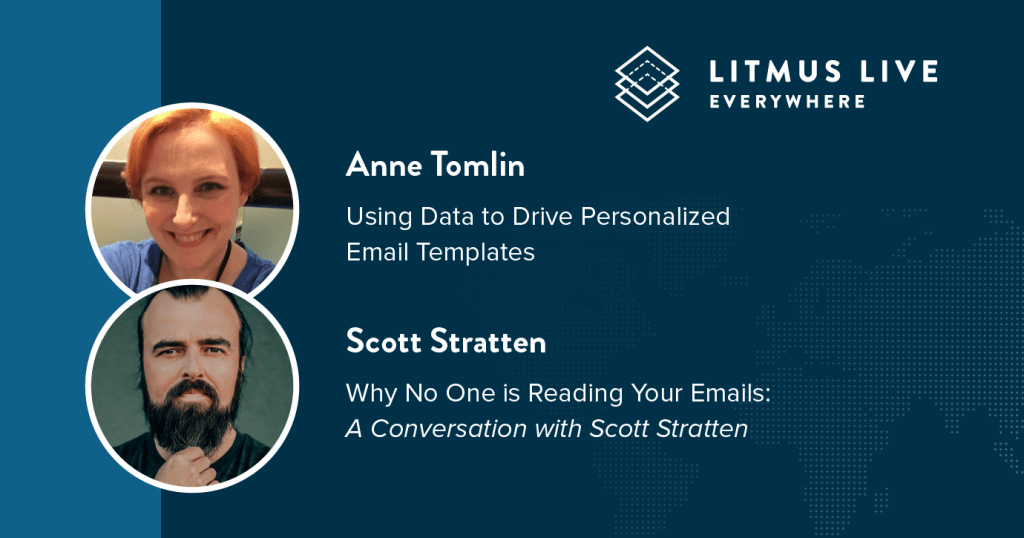June’s Litmus Live Day was all about personalization and using data to tell stories. Scott Stratten, president of UnMarketing, joined us to talk about humanizing your messaging during global unrest, staying true to the needs of your customers, and the disconnect between management teams and marketers on what makes sense to monitor in their email sends. Keep reading for some tweet-able takeaways from Scott and ideas on how to stay personal in your email campaigns.
“Ethics aren’t a renewable resource.”
Wherever you’re in the world, you’ve seen the swells of change brought on by things like pandemics or the fights against systemic racism and inequality. While it’s not the first time citizen-driven movements have permeated culture, people are more closely than ever noticing what companies say in response to these events. While brands can’t necessarily control the reactions of their customers when opinions are publicly expressed, we can make sure the messages we are sending are human and respectful.
A large part of what’s hitting inboxes, social media feeds, and airwaves for the first half of 2020 falls under the umbrella of crisis communications. According to Stratten, brand messages in these situations are most impactful when a few things are allowed to happen:
- Managers work with their teams to align on the big picture and goals, but allow these channel owners to be experts in getting the job done.
- The message is moved out of the echo chamber and limited purviews, allowing broader and more inclusive opinions to review and make suggestions.
- Realizing that, eventually, what you say will reach everybody one way or the other.
Being a marketer in uncertain times is a delicate balance of being responsible to your customers, employees, and vendors, while at the same time ensuring messages continue to work toward meeting your company’s goals. A well-tested and reviewed email can lead the way in making sure you’re represented accurately and truthfully. We’ve pulled together some top tips on what to pay attention to when crafting crisis messages, and encourage you to rely on the thoughts and opinion from your marketing teams before hitting the send button.
“People share their experiences with brands because they’re ecstatic customers, not static customers.”
Some of the most important focus areas in keeping email messages engaging revolve around content and context. With the goal of keeping subscribers coming back to emails, Stratten recommends examining your content and whether it supports the frequency that you’re sending.
Pro tip: One way to battle the “we don’t have enough content” argument actually may lie within your own organization. Use the unique voices and opinions of your employees. Ask your team to contribute thoughts or insights on a topic of interest in your industry, their opinion on a new piece of content or promotion you’re running, or ask them to guest write for a recurring section of your newsletter. Build loyalty and trust by inviting them to represent your brand in the inbox–it’s a simple but effective way to lift people up.
Keeping context in mind is just as important. Make sure your messages tie back to the reason people signed up for your list–and, when in doubt, don’t be afraid to ask why. If you know large portions of your subscribers sign up for your monthly newsletter to take advantage of exclusive offers or deals, it’s probably not a great idea to include extra content that doesn’t serve that purpose. Serving the needs of your subscribers, continually and with focus helps to keep them engaged and evolve into longtime brand advocates. Monitoring engagement and things like clickthrough rates on a regular basis will help you deliver on these expectations, and as customer behavior and interest changes over time, you’ll be able to actively provide the right information.
Speaking of monitoring engagement rates…
“Assumption of knowledge is a problem.”
Measuring our emails against a quantifiable and objective goal is an efficient way to gauge success and know what our subscribers are apt to engage with. In some cases, hundreds of data points are available for each send, and it’s not uncommon for the marketing team to have a different opinion on what to report on than managers or marketing leadership. It’s crucial to the success of everyone involved in making email happen to agree on what should be measured–and clearly define responsibilities from there.
Stratten described this conversation between stakeholders as “matching the metrics with the mind,” and an ideal partnership involving the management team stating goals and from there, placing trust in the hands of the marketing team to lean in and craft experiences in support of these ideas. Along the way, make sure that all members are on the same page with what will be measured, why it’s important to measure this statistic, and what classifies the overall campaign as a success.
Just because Litmus Live Day in June may be over, doesn’t mean the learning has to be. Keep up with Scott on Twitter (@UnMarketing), and check back later this week for insights from Anne Tomlin’s Litmus Live Day session on using data to personalize email templates.

